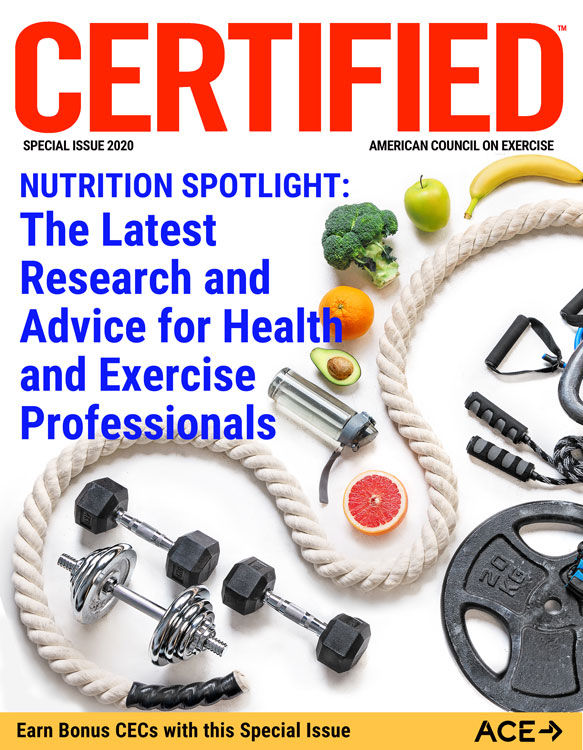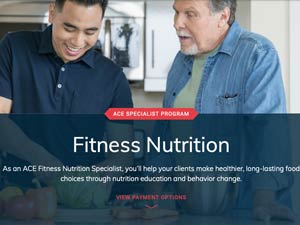
A May 2019 randomized controlled study found that participants who ate more “ultra-processed” food, ate about 500 more calories per day than the control group given a diet of less-processed foods (Hall et al., 2019).
Why did participants eat so many more calories? Ultra-processed foods are not satiating. Unlike nutrient-dense foods with fiber and protein, ultra-processed foods are generally very sweet or salty, provide limited nutrients and are not filling; thus, the need to eat more to feel full. An extra 500 calories per day, of course, could lead to significant weight gain.
As a health and exercise professional, you know that being fit or maintaining a healthy weight requires more than a well-designed exercise program, but you may be wary of offering too much nutritional advice and veering outside your scope of practice. However, given the importance of a healthy diet, providing your clients with sound nutritional guidance is essential. And one of the most impactful changes people can make is learning how to consume a diet that is largely comprised of whole foods.
Of course, most people are not going to be able to switch to an entirely whole-foods diet overnight. Nor is it realistic to expect your clients to completely ditch every ultra-processed food they love. This article examines how you can help your clients learn to make healthier choices most of the time by making small, sustainable changes to "unprocess" their diets.
Identifying Ultra-processed Foods
What is considered ultra-processed food? After all, most food is processed in some way (unless you are growing it yourself), so what defines “ultra-processed” food?
Packaged foods such as chips, fast food, most take-out food and packaged bakery items such as cakes and cookies are generally considered ultra-processed. Refined grains such as white rice, sugary cereals and white bread also are ultra-processed due to the process of separating grains. Refined grains have less fiber and iron and fewer vitamins than their whole-grain counterparts and are less filling due to the lack of fiber.
Foods such as canned or frozen vegetables, whole-grain bread and lunchmeat are considered less processed because they are closer to their original forms (and have more nutritional value).
Not surprisingly, Hall and colleagues (2019) concluded that “limiting consumption of ultra-processed foods may be an effective strategy for obesity prevention and treatment."
Of course, big dietary changes are generally not sustainable and can lead to yo-yo dieting, so helping your clients move to a less-processed diet through small changes may be a sustainable way to help them make nutritional improvements, while also helping them to feel more satisfied by increasing fiber and protein intake.
When it comes to determining the best diet for weight loss, the pendulum has swung wildly over the past several decades, with proponents endorsing everything from low-fat to low-carb, high-fat to high-protein. However, a 2018 12-month randomized clinical trial that included 609 participants found that there is no difference between low-carb and low-fat diets on weight loss. Rather, as the study authors concluded, a balance of macronutrients is best (Gardner et al., 2018).
These two studies (both randomized, control studies, which are the gold standard for scientific evidence) support the idea that a diet comprised of a balance of macronutrients (protein, fat and carbohydrates) that includes more whole foods is best for long-term health (Hall et al., 2019; Gardner et al., 2018). And here’s some good news you can offer your clients: Strict diets aren’t necessary for improving health in the long run.
Of course, telling your clients to eat healthier foods isn’t exactly the most helpful advice. Most people want clearer guidance that they can put into practice, whether it’s about physical activity or diet (or just about anything else in life, for that matter). To that end, here are six practical tips that you can pass along to your clients to help them improve their energy, health and fitness, both in and out of the gym.
1. Consume more fruits and vegetables. When it comes to foods high in nutrients and closest to their original form, fruits and vegetables can’t be beat. They contain fiber, which helps with satiety, and they also aid in digestion. Research shows a high-fiber diet can reduce the risk of disease. The recommended daily intake for fiber is at least 25 grams. For example, a 2016 meta-analysis found that a diet high in fiber can help prevent cancers and cardiovascular disease (Kim and Je, 2016).
Practical advice for clients:
- Add some spinach and a banana in a morning smoothie.
- Snack on raw vegetables. Think: carrot sticks, peppers, sugar snap peas or celery sticks.
- Use dips such as peanut butter, ranch or hummus to enhance the taste of vegetables, if necessary.
- Batch cook a large pan of vegetables to add to other meals. Try broccoli, asparagus, onions, sweet potatoes or bell peppers. Drizzle with olive oil and sprinkle with garlic powder, salt and pepper. To spice it up, add balsamic vinegar or herbs such as basil or rosemary.
- Wash or slice fruit after shopping so it’s ready to go for easy snacking.
2. Avoid sugary drinks. Coffee drinks, smoothies, sodas and mixed alcoholic drinks often contain a surprising amount of sugar and calories. For example, a Starbucks grande java chip Frappuccino made with 2% milk and topped with whipped cream contains 460 calories and 66 grams of sugar. The current guideline for added sugar is less than 25 grams per day (or about 6 teaspoons). Keeping sugary drinks to a minimum can reduce caloric intake and highly processed foods are less satisfying (Hall et al., 2019). This is especially true for drinks. When people drink their calories (especially when high in sugar and low in protein or fiber), they typically still eat just as many calories as they normally would if they hadn't consumed the high-calorie drink.
Practical advice for clients:
- Avoid blended coffee drinks when possible and use less sweetener.
- For mixed alcoholic beverages, opt for seltzer water or a small amount of juice as a mixer.
- Read labels on smoothies; when ordering, ask for no juice, more whole fruits and vegetables, and protein (such as protein powder or peanut butter), if possible.
- When blending smoothies at home, skip the juice and add plenty of whole vegetables (such as leafy greens) and some fruit, and mix in peanut butter or protein powder for a more satisfying shake.
3. Read labels. Food manufacturers are not restricted in some of the nutritional claims they can make on the front of food packaging. For example, phrases such as “all natural,” “now made with protein,” or “includes whole grains,” can make foods seem like a healthy choice. Even two foods that look the same on the front of the package can have drastically different nutrient profiles. In most cases, however, food packaging does not give an accurate representation of a food’s nutritional value, so it’s best to look at the nutritional label on the back of the item.
Practical advice for clients:
Encourage your clients to look at the following when checking nutrition labels:
- Serving size
- Amount of added sugar
- Ingredient list (keeping in mind that ingredients are listed by quantity, with highest listed first)
Here’s a quick tip to offer your clients about sugar: It goes by many different names, even on the same label. Some of the most common are sugar, corn syrup, high fructose corn syrup, glucose, maltose, molasses, brown rice syrup, honey, agave, cane sugar, cane juice, fruit juice concentrate, date sugar, organic raw sugar and sucrose. But that’s only a sampling, as there are more than 50 names for sugar that can be used on labels.
4. Skip convenience foods when possible. Most foods marketed as healthy and portable, such as bars or snacks, are often full of sugar and lack fiber and protein (meaning they are not satisfying). Avoid sugary bars or snacks and opt instead for healthy portable snacks such as those listed below as often as possible.
Practical advice for clients:
Urge your clients to plan ahead by portioning nuts into bags, for example, which can make these healthier options just as easy as grabbing a bar. Encouraging your clients to keep shelf-stable snacks in their purse, gym bag or car can help them avoid last-minute indulgences in the drive-thru or vending machine.
Here are some other healthy snack ideas worth sharing:
- Banana and peanut butter
- ¼-cup portioned nuts with an apple
- Chopped carrots or celery with hummus
- Greek yogurt with fruit
- Homemade granola bars or energy balls (made with oats, peanut butter, etc.)
- String cheese with grapes and whole-grain crackers
5. Ditch the diet mentality. Phrases like “cheat meal” or “cheat day” can end up backfiring. In fact, a 2018 study found that framing less-healthy food as a “cheat” is related to binge behavior (Murray et al., 2018). Instead, help your clients have a healthy relationship with food by reminding them that they don’t need to cut out any foods or food groups.
Practical advice for clients:
- The occasional restaurant meal or dessert is not cause for any stress and should actually be encouraged. In most cases, the more restricted an individual feels with his or her diet, the more likely he or she is to binge or yo-yo with weight.
- Remind your clients to pay attention to how they feel after eating certain foods and encourage them to mostly eat foods that help them feel good and sustain their energy levels.
6. Eat mindfully at restaurants. Eating out can feel like an occasion to indulge, but what happens when your client is eating out more often than he or she is eating at home? Learning how to make healthy choices while eating out is essential to maintaining both health and wellness.
Practical advice for clients:
- If eating out is an infrequent occurrence, encourage your clients to order what they love, but stop eating when full. Restaurants often have very large portions so splitting a meal or having half packed up before it’s brought to the table can reduce the temptation to overeat (and prevent feeling sick after the meal).
- If eating out is a common occurrence due to a busy schedule or a lot of travel, encourage your client to choose a protein-and-vegetable meal with whole grains as often as possible. Here are some examples:
- Sandwich on whole-grain bread with vegetables and turkey
- Salad topped with steak or chicken
- Chicken, beef or other protein with roasted or steamed vegetables
- Whole-grain wrap with lunch meat and vegetables
Small and sustainable changes are more beneficial in the long run when it comes to improving nutrition. Encourage your clients to start with small shifts to avoid the feelings of being overwhelmed that come with trying to make too many big changes all at once.
References
Gardner, C.D. et al. (2018). Effect of low-fat vs low-carbohydrate diet on 12-month weight loss in overweight adults and the association with genotype pattern or insulin secretion. Journal of the American Medical Association, 319, 7, 667−679.
Hall, K.D. et al. (2019). Ultra-processed diets cause excess calorie intake and weight gain: A one-month inpatient randomized controlled trial of ad libitum food intake. Cell Metabolism, 30, 1−11.
Kim, Y. and Je, Y. (2016). Dietary fibre intake and mortality from cardiovascular disease and all cancers: A meta-analysis of prospective cohort studies. Archives of Cardiovascular Diseases, 109, 1, 39−54.
Murray, S.B. et al. (2018). Cheat meals: A benign or ominous variant of binge eating behavior? Appetite,130, 274−278.





 by
by 




